Decorative rats have a high level of intelligence. Such rodents are inquisitive, active and quite easily trained in something new. However, the process of training rats has its own subtleties that pet owners need to know. In our article, we will talk about how to properly train decorative rats.

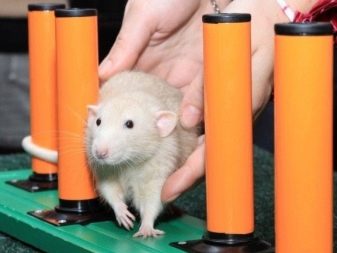
Features
Domesticated rats are an order of magnitude smarter than other types of rodents and can be easily trained. In animals, logical thinking is well developed, which allows them to understand cause-effect relationships. However, the result of training is not always dependent solely on the intelligence of the rat, the skills and patience of the owner.
The process of pet training has its own characteristics and a number of rules that must be observed.
Otherwise, the rat will resist training and there will be no positive effect from studies.
An obligatory component of all training should be motivation. The animal should receive encouragement in the form of goodies for correctly performed actions.
Before starting training, you must establish a trusting relationship with your pet. It makes no sense to try to train the animal if it is afraid of the owner and does not make contact. For classes, it is advisable to take a separate place in the apartment and protect it as much as possible for the pet.

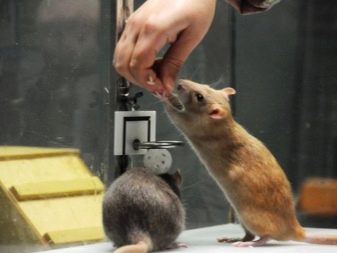
What can be taught?
Rats are inherently highly intelligent. However, this does not mean that all individuals are equally easy to learn. Depending on the character and physiology of the pet, it will be easier to acquire some skills than its brethren, but something will be harder for it.
No matter what it takes to train a pet, good results can only be achieved if all the key points are present in training:
- trusting relationship with a pet;
- motivation in the form of encouraging treats;
- constancy of action;
- fixing the result by repeated repetition;
- patient attitude to the rodent.


Rodents can learn to perform many different tricks. Most often, owners teach their pets the following:
- climb on the shoulder to the owner and sit on it;
- respond to your name and execute simple commands;
- understand the word "no";
- go to the toilet in the tray;
- passing an obstacle course;
- orientation in space and the ability to get out of the maze;
- moving along ropes;
- stand on two paws;
- push the ball in a circle.
Regardless of what the rat will learn, training should be done well in advance. So that the pet does not feel uncomfortable during classes, it does not need to be overfed, but it should not starve either. The rodent must familiarize itself with the training site in advance, as well as with the props.
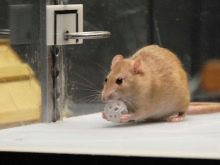

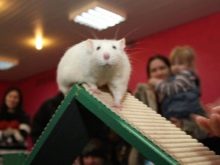
Simple commands
The training of decorative rats is recommended to start with the simplest things. To begin with, the pet must get used to its nickname and begin to respond to it.
At each feeding it is necessary to clearly, but not too loudly pronounce the name of the animal. You can call a rat by nickname during games or simply stroking.
After the animal began to respond and run up to the owner at the call, you can proceed to learning simple commands. For example, the animal can climb onto the shoulder or enter the cage by clicking. When the pet learns simple commands, it will be possible to move on to learning more serious tricks.

Various tricks
You can begin to teach rats to tricks from a stand on their hind legs. Usually they quickly learn this. It is worth considering that the pet must make a stand on its own - you cannot touch it with your hands and put it in the right position. It is necessary to bring a treat to the nose of the rat and gradually raise the food up.
If classes are not held with a well-fed pet, then he will immediately rise after the treat. It is important to give him food when he stands on his hind legs. At the same time as stretching the goodies you can pronounce any command.
After repeated repetition of these actions over several days, the animal will be able to stand on its hind legs on command.
Rats can easily jump. Learning to do this trick is best started on your knees. To do this, the rat must be planted on the left foot, and the right should be taken a little to the side. A treat is placed on the right knee, and the animal will be forced to jump onto the other leg to receive it.
You can also say a command or click when food fits on your foot. Over time, the animal will start jumping over short distances, without requiring a treat. Animals can be taught jumping through small holes or through obstacles.
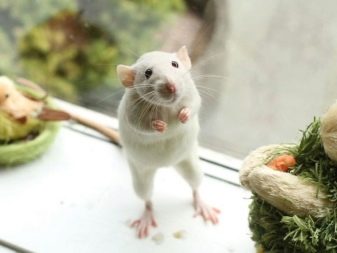

What to do if afraid?
Usually decorative rats willingly make contact with humans and quickly become attached to it. However, there are exceptions among animals. Rodent can be afraid and avoid people. In this case, before proceeding with the training of the pet, it must be tamed.

Hand rodents
It is best if a rat tamed to hands was originally acquired.
However, sellers of pet stores and previous owners are far from always engaged in the education of young offspring. In this case, rodents can behave like wild animals and not trust a person.
Tame rodents can immediately immediately be given into the hands of a new owner. Immediately after buying a pet, you must try to establish contact with him. You need to talk with the animal regularly, and when passing by his home, treat yourself to a treat. It is not recommended to push food into the cage between the rods, as the rat can get scared.
First you need to open the door, call the pet by name, slightly pull the bowl of food and only after that put a treat in it. Decorative rats are quite playful, so you need to spend time daily on games with animals.
It is best to equip a separate zone for games outside the cage and carry the animal there on hand.
Thus, the animal will quickly get used to the hands of the owner, and they will be associated with a pleasant pastime.

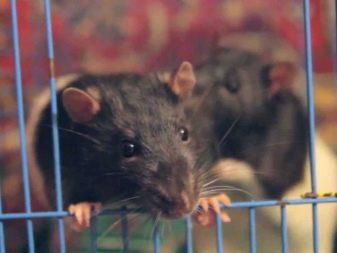
Semi-wild individuals
Taming semi-wild and wild rats will take more time and require patience from the owner.
Semi-wild pets are those individuals that previously came into contact with a person, but were not tamed and are still afraid of people.
First of all, such rats are taught to eat from their hands.
First, for several days in a row, the treat is put in a cage, so that the rodent sees and understands that the owner brought him food. Then you need to carefully bring the delicacy to the animal in the palm of your hand. It is important that the rodent itself approaches the hand and at that moment the main thing is not to make sudden movements so as not to scare away the pet.
The next step is to establish close contact.
The animal must be picked up daily and sit with him on the couch or in the chair for some time.
You can seat the rat on the back of the chair next to you. If the rodent wants to climb outside the collar of clothes - no need to prevent it. Thus, the animal will feel calmer and at the same time begin to get used to the smell of the owner.



Wild
With wild individuals, things will be a little more complicated. Such rodents do not trust people and fear them. They may not allow you to approach yourself, as well as bite in order to protect themselves. The process of taming will be similar to working with semi-wild individuals. However, in this case you will have to show more patience and be extremely careful.
Before you try to feed the animal food from the palm of your hand, you need to accustom it to the smell of your hands, periodically letting them sniff through the cage.
Otherwise, the animal may perceive them as food and painfully bite. In the case when the pet for a long time refuses to approach the palm with a treat, you can specially cut its diet. A little hungry, a rodent is more likely to take food from his hand than to a full stomach.
With a decorative rat, you must constantly talk and call her by name. So she will quickly get used to the voice of the owner and her nickname. At the same time, speech should be calm and without an increase in intonation.
After the animal ceases to be afraid of eating from his hands, it must be taken out of the cage and accustomed to the outside world.
It is enough just to take the pet in your arms, go with it to any convenient place in the room, and then sit next to it. So the pet will understand that the world around is not dangerous, and the owner does not want to harm him. When the taming stage is successfully completed, you can start training.
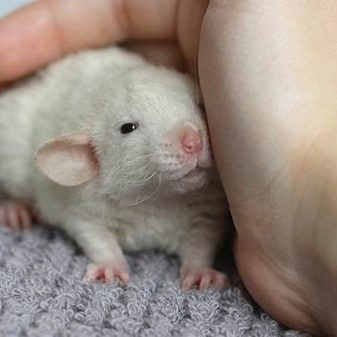
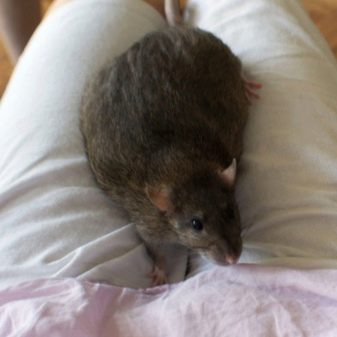
Professional Tips
Despite the fact that decorative rats respond well to training, it is recommended to follow certain rules in the process of training at home. It is undesirable to do activities with the animal too long.
The training time should not be more than twenty-five minutes. After the specified time, the rodent may tire and lose concentration.
During classes, it is advisable to praise the pet as often as possible. Endorsement by the owner will help the rodent to feel more confident. At the same time, it is worth monitoring the volume of the voice and intonation: rats do not like loud and sharp sounds and movements. If the pet refuses to carry out any command, then punishing him for disobedience is strictly prohibited.


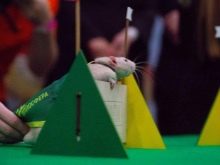
The training process will not be so productive if the rat is not tamed to humans. The animal needs to pay a lot of attention not only during classes. In order for the rodent not to be afraid of the voice, it is necessary to talk with him regularly and a lot.
If you need to train more than one rodent, then you need to make sure that all pets receive the same amount of attention.
However, do not train males and females of rats together, as this can distract them. It is recommended to include a game element in the training process. Thus, animal studies will be of greater interest.
In the learning process, not only verbal praise is necessary, but also encouragement by a treat. It can be pieces of fruit or nuts, as well as other favorite pet food. It is important that there are not very many goodies, since the rodent should not be full. Another rule of training is the transition from easy exercises to more complex ones.


About how the process of training a rat occurs, see the video below.










